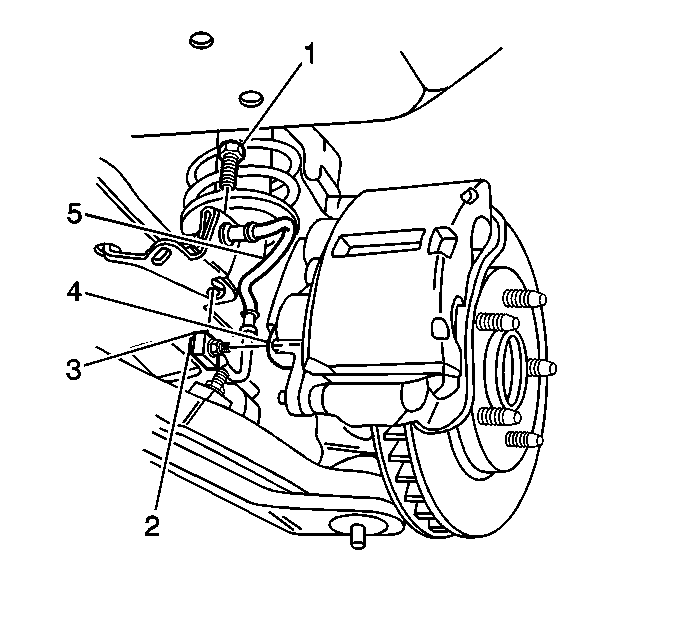Removal Procedure
Notice: Avoid spilling brake fluid onto painted surfaces, electrical connections,
wiring, or cables. Brake fluid will damage painted surfaces and cause corrosion
to electrical components. If any brake fluid comes in contact with painted
surfaces, immediately flush the area with water. If any brake fluid comes
in contact with electrical connections, wiring, or cables, use a clean shop
cloth to wipe away the fluid.
- Raise and support the vehicle.
Refer to
Lifting and Jacking the Vehicle
- Remove the tire and wheel. Refer to
Tire and Wheel Removal and Installation
in Tires and Wheels.

- Clean all dirt and foreign
material from the front brake hose and the front brake hose fitting (4).
- Remove the front brake pipe from the front brake hose.
| • | Use a backup wrench on the hose fitting. |
| • | Do not bend the front brake hose bracket (2) or front brake pipe. |
- Remove the brake hose retainer from the hose fitting at the brake
hose bracket.
- Remove the brake hose (5) from the brake hose bracket (3).
- Remove the following components from the front brake caliper (4):
| • | The brake hose fitting (2) |
| • | The brake hose clip bolt (1) |
| • | Two brake hose fitting gaskets |
| • | Discard the two old brake hose fitting gaskets. |
Installation Procedure

- Lubricate the brake hose
bolt (1) threads with clean brake fluid.
- Install the following components to the front caliper (4):
| • | The brake hose fitting (2) |
| • | The brake hose clip bolt (1) |
| • | Two new brake hose fitting gaskets |
Notice: Use the correct fastener in the correct location. Replacement fasteners
must be the correct part number for that application. Fasteners requiring
replacement or fasteners requiring the use of thread locking compound or sealant
are identified in the service procedure. Do not use paints, lubricants, or
corrosion inhibitors on fasteners or fastener joint surfaces unless specified.
These coatings affect fastener torque and joint clamping force and may damage
the fastener. Use the correct tightening sequence and specifications when
installing fasteners in order to avoid damage to parts and systems.
- Ensure that the
hose fitting flange engages the front caliper orientation ledge.
Tighten
Tighten the front brake hose fitting to 40 N·m (30 lb ft).
- Install the brake hose (5) into the brake hose bracket (3). Ensure
that there are no kinks in the brake hose.
- Install the brake hose retainer at the brake hose bracket.
- Install the front brake pipe to the brake hose.
- Install the brake hose retainer.
- Secure the retainer to the brake hose bracket using the screw.
| • | Use a backup wrench on the hose fitting. Ensure that the brake
hose does not contact any part of the suspension. |
| • | Inspect the hose in the extreme right and extreme left turn conditions. |
Tighten
Tighten the front brake hose clip bolt (1) to 13 N·m (115 lb in).
- Bleed the brake hydraulic system. Refer to
Hydraulic Brake System Bleeding
.
- Install the tire and the wheel. Refer to
Tire and Wheel Removal and Installation
in Tires and Wheels.
- Lower vehicle.


